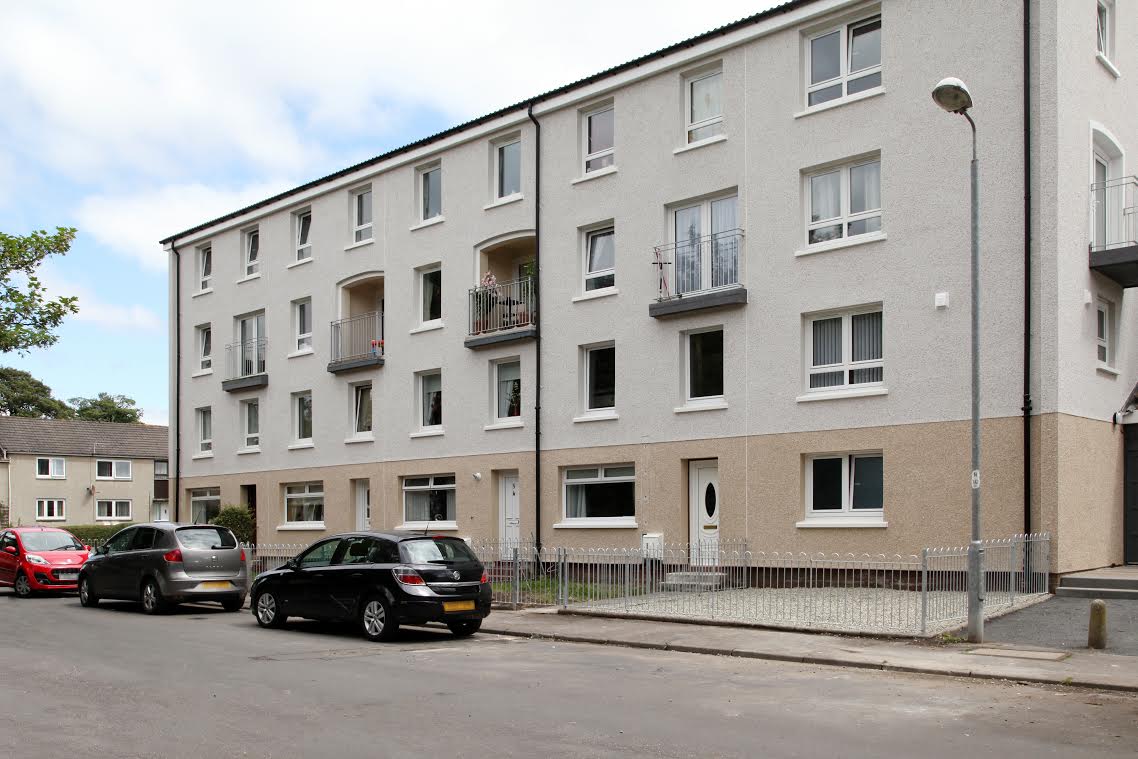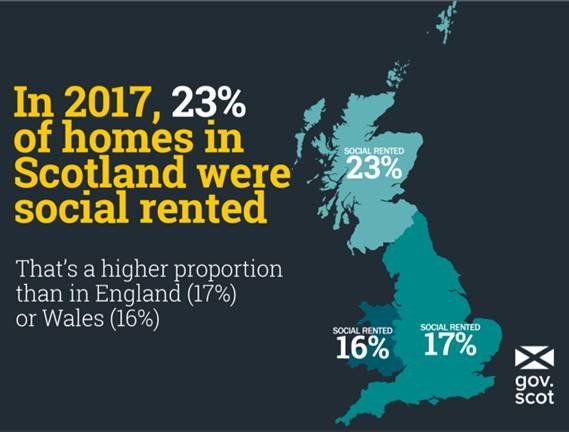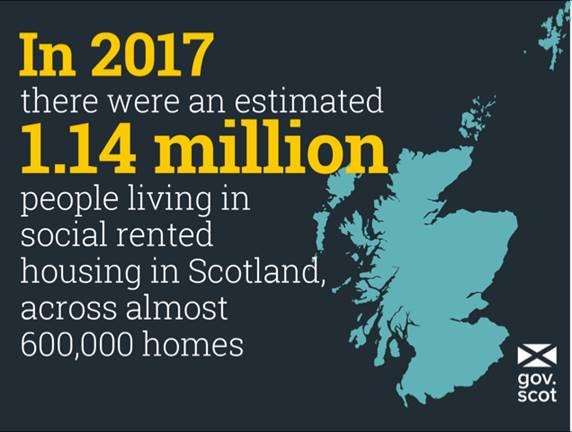Communities secretary ‘encouraged’ by social tenants and housing statistics
New statistics on social tenants and social rented housing in Scotland reflect the Scottish Government’s ongoing commitments to delivering suitable housing, communities secretary Aileen Campbell has said.
Social Tenants in Scotland 2017, published yesterday, is the third annual statistical compendium publication covering topic areas such as stock, household characteristics, housing flows, and rents and income levels.

Ms Campbell highlighted the higher rate of supply of affordable and social rented housing in Scotland compared with England and the “encouraging” affordability of social homes in Scotland compared with England and Wales.
The report found that 34% of social rented households in Scotland spent more than 30% of their net income on housing costs in the period 2015/16 to 2017/18, lower than the equivalent figures of 49% for England and 48% for Wales.
In 2017/18, the £70.73 average weekly local authority rent in Scotland was around 18% lower than in England (£86.71), and around 16% lower than in Wales (£84.65). The £82.28 average weekly housing association rent in Scotland was around 14% lower than in England (£95.59), and around 6% lower than in Wales (£87.10).

The communities secretary said: “Making sure everyone has a safe, warm and affordable home is central to the Government’s vision for a fairer and more prosperous Scotland. We remain on track to deliver on our ambitious target to deliver 50,000 affordable homes, including 35,000 for social rent during the lifetime of this Parliament, backed by over £3 billion of investment.
“Since 2007 more than 82,000 affordable homes have been delivered, including 55,920 homes for social rent. These figures reflect the Scottish Government’s ongoing commitments to delivering suitable housing, which also supports our aims to end homelessness and reduce fuel poverty.
“Between 2007/08 and 2017/18, the supply of affordable housing in Scotland was a third higher than in England, and within this the rate of supply for social rented housing was even higher – more than double that in England.
“It is encouraging to see that the social housing being delivered in Scotland continues to be more affordable than England or Wales, which is vital at a time when UK Government welfare cuts are having a devastating impact on people across the country.”

However, with a slight decrease in the overall number of social rented housing stock in 2017 compared with a year earlier, Ms Campbell said there is still work to be done to increase the numbers of homes.
The total stock in 2017 reached 593,841 units (314,816 local authority properties and 279,025, housing association properties), 791 (0.1%) homes less than the 594,632 units in 2016.
Ms Campbell added: “There is still more work to be done to increase the number of social housing units available across Scotland. We have put in place a number of measures to deliver that, in addition to ending the right to buy, keeping existing social housing stock in the sector and protecting it for future generations.
“We will continue to work with the housing sector to deliver our ambitious target of 50,000 affordable homes by 2021.”
The publication is based on an analysis of a range of existing data sources, and includes trend data for earlier years and comparisons with other housing tenures and with other parts of the UK where possible.
Key Points
Numbers of Social Tenants and Social Housing Stock Provision:
- There were an estimated 1.14 million people living in social rented housing in Scotland in 2017, a similar figure to the estimated 1.17 million people in the previous year.
- Social rented housing stock in 2017 was provided by 161 housing associations and 26 out of 32 local authorities. (With 6 authorities no longer managing housing stock due to previous stock transfers to housing associations).
- Social rented housing stock in 2017 totalled 593,841 units (314,816 local authority properties and 279,025, housing association properties), a slight decrease of 791 (0.1%) homes from 594,632 units in 2016.
- Local authorities generally had a larger size of stock in 2017 compared to housing associations, with almost two-thirds (65%) of the 26 local authorities having stock levels between 5,001 and 20,000 homes, whilst more than eight in ten (83%) housing associations had stock levels of 2,500 homes or less.
- 69% of housing associations operated in a single local authority area in 2017, 17% operated in 2 to 5 different local authority areas, whilst the remaining 14% operated across 6 or more local authority areas.
- At a Scotland level 53% of social rented housing stock in 2017 was owned by local authorities, with 47% being owned by housing associations.
- In 2017 Scotland had a higher proportion of social renting stock (23%) compared to both England (17%) and Wales (16%).
Characteristics of Social Tenants:
- 29% of social rented households in 2017 were single working age adults, an increase from 18% in 1999. 20% of households were single pensioners, a decrease from 25% in 1999.
- The average age of the highest income householder in social rented housing in 2017 was 53 years, the same average as 53 years in 1999.
- Social rented households in Scotland in 2017 had a higher proportion of female highest income householders (54%) than private rented households (43%), households with the property bought with a mortgage (33%) and households where the property was owned outright (39%).
- 38% of adults in social rented households in 2017 were employed (24% employed full time, 11% employed part time, and 2% self-employed). 25% of adults were retired from work, 12% were permanently sick or disabled, 9% were looking after the home or family, and 9% were unemployed and seeking work.
- In the period 2013 to 2017, 86% of adults in social rented households stated they were ‘White Scottish’, a higher percentage than private rented households (57%).
- 3% of adults in social rented households identified as lesbian, gay, bisexual or other in 2017, compared to 5% of adults in the private rented sector, 2% of adults in households owned with a mortgage, and 1% of adults in households that were owned outright.
- In the period from 2013 to 2017, 53% of adults in social rented housing said they had no religion, an increase on the 45% between 2009 and 2012. The percentage of adults with a Church of Scotland religion decreased over this time period from 29% to 22%, whilst the proportion with a Roman Catholic religion stayed similar from 18% to 17%.
Housing Flows:
- In 2017/18 there were a total of 53,602 social rented housing lets, an increase of 678 lets, or 1%, on the 52,924 lets in 2016/17.
- In 2017/18 48% of lets were by local authorities, and 52% were by housing associations. This compares to local authorities having 53% of all social rented housing stock as at March 2017.
- 35% of lets by local authorities in 2016/17 were to housing list applicants, compared to 52% of lets by housing associations. (Where applicants were not already existing tenants).
- In 2017/18 90% of local authority lets and 82% of housing association lets were general needs lets, the same figure as in 2016/17.
- Adults in social rented households in Scotland in 2016 had been at their current address for an average of 11 years, a shorter average time than in 1999 (12 years).
- Local authority properties were on average empty for 34.3 calendar days before being re-let in 2017/18. Housing association properties were on average empty for 27.2 calendar days.
- For social rented households in Scotland in which an adult had moved into the address within the last 12 months in 2017, almost half of adults (45%) had a previous address which was also social rented. 22% had a previous address that was their parental/family home, whilst 21% had a previous address that was rented privately.
Housing Costs and Income:
- The average weekly rent for a social sector property in Scotland in 2017/18 was £76.23, an increase of 2.4% on the previous year. Housing association rents averaged £82.28 per week, 16% higher than local authority rents of £70.73.
- In 2017/18, the £70.73 average weekly local authority rent in Scotland was around 18% lower than in England (£86.71), and around 16% lower than in Wales (£84.65). The £82.28 average weekly housing association rent in Scotland was around 14% lower than in England (£95.59), and around 6% lower than in Wales (£87.10).
- 69% of social rented households in 2017 had a net income of £20k or less, which compares to 46% of private rented households, 65% of households owned outright and 14% of households buying with a mortgage.
- Across the period 2015/16 to 2017/18, social rented households in Scotland spent an average of 24% of their net income on housing costs. This figure compares to equivalent figures of 27% for private rented households, 8% for households owning their property with a mortgage and 3% for households owning their property outright. (Note that housing costs include rent gross of housing benefit, as well as water rates and service charges where applicable. Net income relates to all household income after personal taxes and council tax have been netted off. See Section 5 of the publication for further details of how this percentage figure has been calculated).
- 34% of social rented households in Scotland spent more than 30% of their net income on housing costs in the period 2015/16 to 2017/18, lower than the equivalent figures of 49% for England and 48% for Wales.
- 59% of social rented households received housing benefit in 2017, with a further 2% receiving the housing element of universal credit. This compares to 23% of private rented sector households receiving housing benefit, with a further 2% receiving the housing element of universal credit.
- For households claiming housing benefit, social rented households had on average 94% of the value of their housing costs covered by housing benefit (calculation based on a median ratio figure), which compares to 83% for private rented households.
- In 2017, 30% of social rented households in Scotland stated that they managed well financially, an increase from 21% in 1999.




